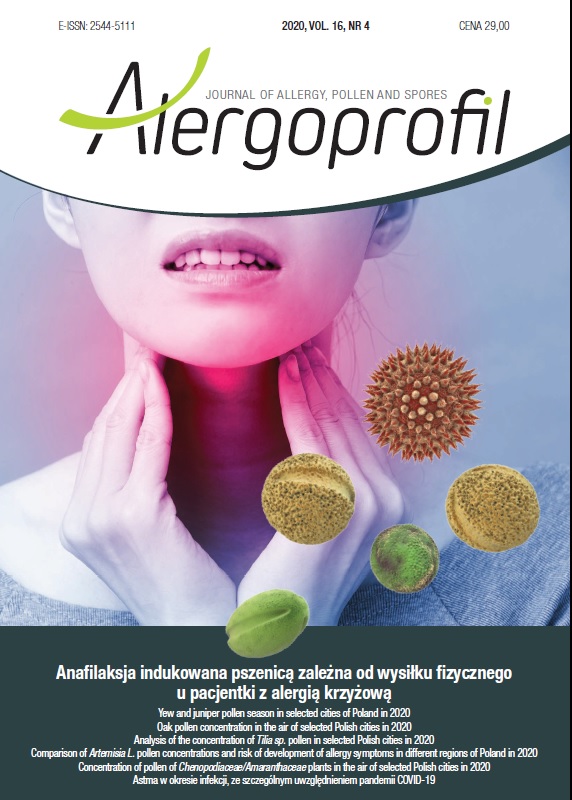Oak pollen concentration in the air of selected Polish cities in 2020 Original article
##plugins.themes.bootstrap3.article.main##
Abstrakt
The study aims to compare the oak pollen season in selected Polish cities: Bialystok, Bydgoszcz, Cracow, Katowice, Piotrkow Trybunalski, Lublin, Olsztyn, Opole, Szczecin, Warsaw, and Wroclaw in 2020. Measurements were made using the volumetric method, with a Hirst-type sampler. Oak pollen season, defined as the period with 98% of the annual total catch, started between April 14th (in Opole) and April 25th (in Lublin). The season ended on June 1st at the latest; in Sosnowiec, Bydgoszcz, Olsztyn, and Bialystok. It lasted from 30 to 47 days (37 days on average). The maximum daily oak pollen concentrations were observed between April 24th and May 11th. The highest annual sum of oak pollen grains (SPI) was recorded in Lublin, while the lowest in Bialystok. The highest concentrations of 596 oak pollen grains/m3 were noted in Lublin on April 28th. The longest exposure to high concentrations of oak pollen (> 91 grains/m3), lasting 12–13 days, was recorded in Lublin, Opole, and Wroclaw.
Pobrania
##plugins.themes.bootstrap3.article.details##

Utwór dostępny jest na licencji Creative Commons Uznanie autorstwa – Użycie niekomercyjne 4.0 Międzynarodowe.
Copyright: © Medical Education sp. z o.o. This is an Open Access article distributed under the terms of the Attribution-NonCommercial 4.0 International (CC BY-NC 4.0). License (https://creativecommons.org/licenses/by-nc/4.0/), allowing third parties to copy and redistribute the material in any medium or format and to remix, transform, and build upon the material, provided the original work is properly cited and states its license.
Address reprint requests to: Medical Education, Marcin Kuźma (marcin.kuzma@mededu.pl)
Bibliografia
2. Skjøth CA, Šikoparija B, Jäger S. EAN-Network. Pollen sources. Allergenic Pollen. Springer Netherlands, Dordrecht 2013: 9-27.
3. Bugała W. Drzewa i krzewy. Państwowe Wydawnictwo Rolnicze i Leśne, Warszawa 2000.
4. Egger C, Focke M, Bircher AJ et al. The allergen profile of beech and oak pollen. Clin Exp Allergy. 2008; 38: 1688-96.
5. Rapiejko P, Lipiec A, Jurkiewicz D. Alergogenne znaczenie pyłku dębu. Alergia. 2004; 2: 38-41.
6. Ferreira F, Gadermaier G, Wallner M. Tree pollen allergens. Global Atlas of Allergy 2014: 18-21.
7. Breiteneder H, Kleine-Tebbe J. PR-10-like allergens. In: Maticardi PM, Kleine-Tebbe J, Hoffmann HJ et al. EAACI Molecular Allergology. User’s Guide 2016: 299-309.
8. Scala E, Asero R, Niederberger V. Tree pollen allergens. In: Maticardi PM, Kleine-Tebbe J, Hoffmann HJ et al. EAACI Molecular Allergology. User’s Guide 2016: 71-83.
9. Emberlin J, Savage M, Jones S. Annual variations in grass pollen seasons in London 1961-1990: trends and forecast models. Clin Exp Allergy. 1993; 23(11): 911-8.
10. Galan C, Artaitti A, Bonnini M et al. Recommended terminology for aerobiological studies. Aerobiologia. 2017: 293-5. http://doi.org/10.1007/s10453-017-9496-0.
11. Burge HA. Monitoring for airborne allergens. Ann Allergy. 1992; 9: 9-21.
12. Dąbrowska-Zapart K, Chłopek K, Malkiewicz M et al. Oak pollen season in selected cities of Poland in 2019. Alergoprofil. 2019; 15(2): 12-6.
13. Puc M, Myszkowska D, Chłopek K et al. Oak pollen in the air of Poland in 2017. Alergoprofil. 2017; 13(3): 124-8.
14. Sulborska A, Weryszko-Chmielewska E, Piotrowska-Weryszko K et al. The oak pollen concentration in the air of selected cities in Poland in 2018. Alergoprofil. 2018; 14(3): 67-71.
15. Grundströma M, Adams-Groom B, Pashley CH et al. Oak pollen seasonality and severity across Europe and modeling the season start using a generalized phenological model. Sci Total Environ. 2019; 663: 527-36.

